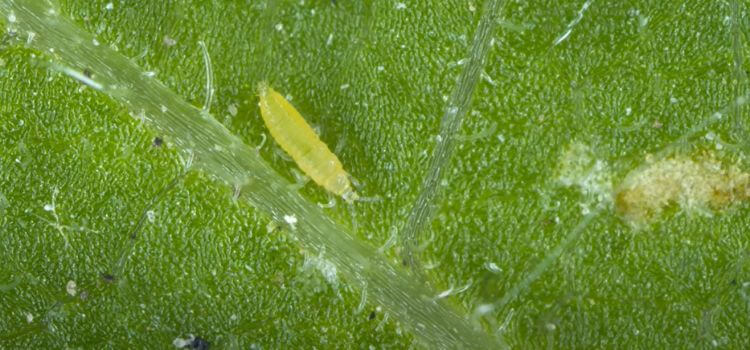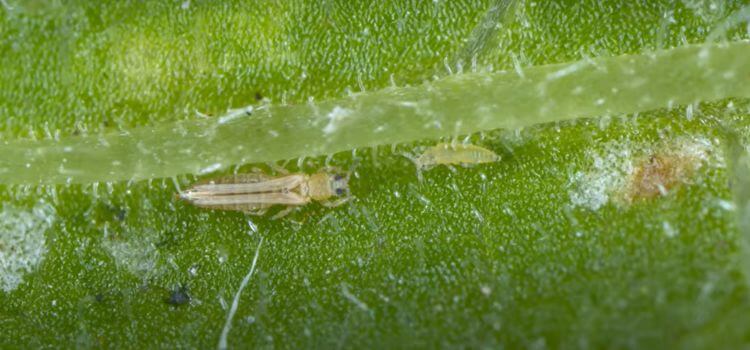As an Amazon Associate, I earn from qualifying purchases.
Thrips rely on plants to survive, as they feed on plant tissues. Without plants, their lifespan is significantly reduced.
Thrips, tiny, slender insects notorious for damaging plants, pose a substantial challenge for gardeners and farmers worldwide. These minute pests extract nutrients by puncturing and sucking up the contents of plant cells, which can lead to distorted growth, defoliation, and even the death of the plant.
As a result, understanding the dependency of thrips on plants is crucial for effective pest management. Garden enthusiasts and agricultural professionals alike strive to curb the spread of thrips to protect their vegetation. By implementing integrated pest management strategies, including the removal of infested plants, they aim to reduce the habitats available for thrips, thereby limiting their ability to thrive and reproduce.
Lifecycle Of Thrips
Understanding the lifecycle of thrips is critical to answering whether they can live without plants. These tiny insects go through several distinct stages, from egg to adult. Let’s delve into each phase and uncover their development process.
Egg Stage
Thrips begin their lives as eggs. Females lay them in plant tissue. These eggs are so small that spotting them with the naked eye is challenging. Depending on the temperature, they hatch in days.
Larval Stage
After hatching, thrips enter the larval stage, which has two parts. During both, larvae feed voraciously on plant sap. They increase and shed their skin to progress.
Pupal Stage
Next is the pupal stage. Thrips find shelter in soil or leaf litter. They do not feed during this time. Instead, they transform into their adult form. This stage can last for a week or more.
Adult Stage
Finally, thrips emerge as adults. Adult thrips fly to new plants to feed and mate. They can live for a month or so, laying hundreds of eggs in their lifetime. Their survival hinges on finding plants to sustain them.

Feeding Habits Of Thrips
Are you curious about thrips’ feeding habits? These tiny insects are notorious for their diet, which relies heavily on plant matter. Understanding what they eat is crucial for controlling their presence in gardens and farms.
Types Of Plants Thrips Feed On
Thrips are not picky eaters. They target a wide array of plants. Here’s a quick rundown:
- Vegetables: Tomatoes, onions, and beans are among their favourites.
- Flowers: Roses, lilies, and daisies often fall victim to thrips.
- Fruits: They enjoy citrus fruits and soft-skinned berries.
- Ornamentals: These pests are known to infest houseplants and decorative shrubs.
Damage Caused By Thrips
Thrips feeding can lead to severe plant damage. Here’s what to look for:
| Sign of Damage | Description |
|---|---|
| Discoloration | Leaves and petals may develop silver-white streaks or spots. |
| Deformation | New growth may twist or curl, and flowers may become misshapen. |
| Stunted Growth | Infested plants may grow slowly or not at all. |
| Fruit Damage | Fruits may exhibit scars or fail to develop properly. |
Identifying and controlling thrips early can prevent these issues, keeping plants healthy and thriving.
Adaptations Of Thrips
Thrips are highly adaptable insects that rely on plant life to thrive. Despite this, some species can survive on other organic matter if vegetation is scarce, showcasing their remarkable resilience and flexibility in various environments.
Thrips are tiny insects known for their unique survival abilities. These abilities allow them to live in various environments, not just on plants.
Survival Mechanisms
Thrips have developed several fundamental survival mechanisms to withstand different environments:
- Desiccation resistance: Thrips can tolerate dry conditions, which helps them survive without plants.
- Small size: Their tiny bodies allow them to hide from predators easily.
- Reproductive adaptability: Thrips can reproduce quickly, increasing their chances of survival.
Alternative Food Sources
Thrips do not rely solely on plants for food. They have adapted to exploit various alternative food sources:
- Fungi: Many thrips feed on fungi, which are abundant in different environments.
- Organic debris: Thrips can consume dead plant material, helping them survive without live plants.
- Other insects: Some thrips are predators, feeding on other small insects and mites.
This versatility in diet helps thrips to live in areas where plants are not available.
Impact On Ecosystem
The presence of thrips, tiny insects often found on plants, plays a significant role in ecosystems. Understanding their impact is crucial for recognizing the delicate balance of our environment. Here, we explore how thrips interact with their surroundings and the consequences they have on plant diversity.
Role Of Thrips In Ecosystem
Thrips are more than just plant dwellers; they contribute to the ecosystem’s complexity. These insects serve as both prey and pollinators. Many small predators rely on thrips for food, creating a vital link in the food chain. As pollinators, thrips assist in the reproduction of certain plant species. This dual role supports biodiversity and helps maintain a healthy ecosystem balance.
- Prey for predators: Maintains predator populations.
- Pollinators: Enables plant reproduction.
Effects Of Thrips On Plant Diversity
Thrips can both positively and negatively affect plant diversity. On the one hand, their pollination activities can enhance plant reproduction and genetic diversity. On the other hand, thrips can cause damage to plants by feeding on them. This can lead to reduced plant vigour and survival, influencing the variety of plant life in an area.
| Positive Impact | Negative Impact |
|---|---|
| Promotes genetic diversity | Can lead to plant stress |
| Supports plant growth | May reduce plant populations |
Research Findings
Thrips, tiny insects known for their plant-feeding habits, are a common concern for gardeners and farmers. Their ability to survive without plants has puzzled many. Recent research sheds light on this topic, revealing fascinating aspects of thrips’ resilience and adaptability.
Studies On Thrips Behavior
Scientists have conducted various studies to understand how thrips behave. These studies aim to discover whether thrips can live without plants. The findings show that thrips are adaptable. They can survive in different conditions, but their longevity and health suffer without plant access. Key behaviours observed in these studies include:
- Feeding patterns: Thrips typically feed on plants but can consume other food in the absence of vegetation.
- Reproduction rates: Without plants, thrips reproduce less. This affects their population size.
- Movement: Thrips may travel long distances to find plants or suitable habitats.
Thrips Behavior In Controlled Environments
In controlled environments, like labs, researchers can observe thrips without plants. These observations provide insights into their survival tactics. Thrips have been seen resorting to:
- Alternative diets: In the absence of plants, thrips may feed on fungi or other organic matter.
- Conservation of energy: They become less active in reducing energy needs.
- Life cycle changes: Thrips may alter their life cycle stages to adapt to the available resources.
Controlled studies affirm that while thrips can endure for a time without plants, their survival is compromised. Plants are essential for their optimal growth and reproduction.
Control Measures
Effective control measures are essential in combating thrips that threaten plants. Thrips can indeed survive without plants for a short period. Yet, they need plant tissue to thrive and reproduce.
Biological Control
Introducing beneficial insects like ladybugs and lacewings can help. These predators naturally reduce thrip populations. Another option is using parasitic wasps, which target and suppress thrips.
- Ladybugs – eat thrips at various stages
- Lacewings – consume thrips larvae
- Parasitic wasps – lay eggs in thrips, controlling their numbers
Chemical Control
Chemical pesticides are effective but should be a last resort. They can harm beneficial insects and the environment. Use insecticidal soaps or neem oil as safer alternatives. Always follow label instructions.
| Product | Application Method | Frequency |
|---|---|---|
| Insecticidal soaps | Spray on affected areas | Every 7-10 days |
| Neem Oil | Apply as directed | As needed |
Cultural Control
Good gardening practices help prevent thrip infestations. Remove weeds and debris to eliminate thrip habitats. Regularly inspect plants and isolate infested ones to stop the spread.
- Remove weeds and garden debris.
- Check plants frequently for signs of thrips.
- Isolate infested plants immediately.
Frequently Asked Questions
Thrips typically do not go away on their own. Without intervention, they can continue to infest and damage plants. Effective treatment and control measures are necessary to eliminate thrips.
Thrips generally do not live on clothes; they prefer plants. Clothing may temporarily carry them if in contact with infested vegetation.
Thrips do not need soil to survive. They thrive on plants, feeding on their leaves and flowers. Managing them involves regular plant inspection and prompt removal of infested foliage.
No, you don’t need to throw away a plant with thrips. Treat the infestation with insecticidal soap or neem oil to control and eradicate the pests. Regular monitoring and treatment can save your plant.
Conclusion
Wrapping up, thrips require plants for survival, thriving on the nutrients they provide. Without this vital source, their lifecycle is compromised, leading to a decline in population. Gardeners should remain vigilant, as these pests can quickly overtake healthy vegetation. Remember, healthy plants are your first defence against thrip infestations.

